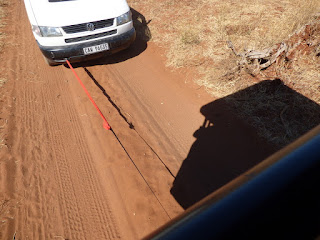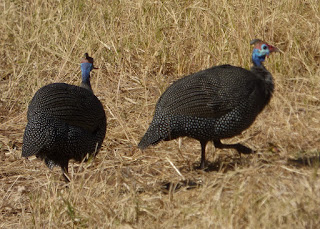7/6 -- Today, we woke up to baboons in the tree near us exiting as
a group and heading out to the river wherever 'work' was for them. They
started leaving just before the sun was
totally up, making picture taking challenging.
After a light breakfast, we started exploring Chobe National
Park. If possible, the entry road is worse than most the roads in Thornybush --
deeply rutted sand with dips alternating on each side of the track so we were
constantly swinging side to side. First up was a large herd of Cape Buffalo, followed by a
bunch of vultures at the waterfront. As we watched, the vultures flew off one
at a time -- because their wings are so long, they need to jump up for the
first couple steps to get any lift. We saw zebra, waterbuck, egrets, a coppery
coucal, and elephant tracks. When they walk, they place their back foot, in the
footprint of the front foot, which is a bit larger to help support the weight
of their head.
 |
| Cape buffalo herd |
 |
| Burchell Zebra herd on the plains -- pronounced zeb-ra here. |
 |
| Vultures |
 |
| Egrets - just like home |
 |
Double elephant foot print -- lower one is the front foot and
the hind foot fits inside. |
 |
| Waterbucks. |
 |
| Coppery Coucal |
When we headed back
inland, we saw several hyenas and a jackal sparing for pieces of a zebra.
Oddly, there were zebra nearby who just kind of ambled along as their buddy was
getting demolished. The jackal is considerably smaller than the hyena (and
possibly smarter). When they would fight each other for a piece, he would grab
a small piece and dart off to sample it, and then bury it before going back for
another hunk. Toward the end of our stay
there, the vultures sauntered up hoping to get in on the action,
unsuccessfully. Although kind of gruesome, it is the circle of life and
interesting to see in person.
 |
| Hyena with zebra leg |
 |
| Black--back jackal with his stolen piece |
 |
| Jackal going back for more |
 |
| Zebra watching the hyena dine on a pal |
 |
| Vulture waiting his turn |
Things got more upbeat after that, with lots more animal and bird sightings.
 |
| Giraffe trying the grass |
 |
| Male kudu |
 |
| Baby zebra |
 |
| The Burchell Zebra has a 'shadow stripe' between the black ones. |
 |
| Lilac- breasted roller -- even prettier in flight |
 |
| One of the hornbills |
 |
| Buffalo Weaver - one of the Little Five - below his enormous nest |
One of our group asked about crossing the bridge to Namibia
and coming back, so we took an impromptu jaunt to another country. The bus
drove us to the border, less than a mile away, and we exited Botswana, which
ended up being VERY slow because the computers were down and it had to be done
by hand. Finally, we clamored back onto the bus for the trip over where we got
entry and exit stamps, and crossed back to Botswana, where the computers were
working again.
 |
The crew who went to Namibia -- bus driver, Lynn, Jim, Karyn,
Millie, Jim, Bob |
 |
| Baobob tree near the Botswana Immigration Office |
In the late afternoon, we headed out to meet a women's group
in the nearby town of Mabele. We met Henriety, a leader of the group, who
showed us her garden and house before introducing us t o the
others. They make basketry items in the
traditional way and shared how they are dyed, using modern materials in some
cases: old soda can tops produce gray, and when combined with the root
for dark brown, you get black. They
gave a couple of us a chance to weave, then we had a chance to buy things they had
made. On the way back to camp, we stopped at the river with a
table set up to serve wine and snacks. and enjoyed watching the sun go down
over the river.
 |
| This billboard was along the road where we turned to the village. |
 |
| Ladies entertaining us before the basket demo |
 |
| Sundown treat |
 |
| Zebras at sunset at river's edge |
 |
| Waterbucks and zebras |
 |
Sunset over the river
|
7/7 - As we went to breakfast, the baboon troop that lives
in the tree outside our room left to go to the office for the day and Jim
snapped a really nice picture of 3 of them before they left the house.
We had
what was billed as a 20 minute drive on the highway to another more
river-oriented area of Chobe. In an open vehicle on a highway when the outside
temperature is in the 50s is a seriously cold experience, even with the lined
ponchos provided. I had on 2 shirts, a down jacket, a lightweight soft shell,
and a heavy fleece with a billed cap topped by a very warm fleece hat with the
poncho wrapped around me from the waist down. The jeep only went about 25 MPH
and I think it took at least twice as long as they projected.On the way to the park, we saw zebras, kudu, and an odd bird
called a bustard.
 |
If you click on this photo, you can clearly see the
shadow stripes |
 |
| Bustard |
Once we got there, there were more kudu and then we
encountered a big elephant herd, which decided to cross the road in front of
us, so we sat back and watched and took pictures. There was a very young calf
in the group -- maybe a couple weeks old who was still nursing and short enough
to run under its
mom. There were also a
number of younger elephants in addition to the tiny baby. Elephants typically
only give birth every 6 years --it takes 22 months to gestate and moms don't
come into season again until the young one safe.
 |
| Baby elephant nursing |
Next, we saw helmeted guinea hens -- they have a crest on
their heads like male quail-- more impala and a weird gray bird with yellow
wattles hanging down from the corner of its eyes to below its yellow beak. We
also caught sight of an elusive honey badger running thru a field of tall grass
-- it looks a lot like a skunk with a wide gray stripe. There were lots of
giraffe too, and several times they looked like twins or as though their necks were entwined.
Later, there were elephants again and one came toward us
pretty aggressively and stopped only about 10 feet from the truck. The guides
say they can identify the signs that the elephant is really charging, but
sitting on an upper row in the truck on the side of the "not-a-real
charge" is more excitement than I need.
We stopped for lunch at a picnic area where they warned us
not to feed the monkeys and we took some tables under the monkey tree. Bad
idea. Sammie told us each to pick up a stick
to warn the monkeys away, which kept us pretty busy. Even with 14 of us
protecting the food, the monkeys made several successful incursions, including
at the end when one ripped a hole in the garbage bag.
 |
| Vervet monkeys like the ones who visited us at Thornybush |
From there, we got word of a lion sighting, so we headed
over to check it out. On the way, a
self-driver stopped us and asked if we could radio the park HQ for help because
a mini-van had gotten stuck in deep sand. We could see them below us seriously
hung up in the sand in a vehicle that should never have been there.
Unfortunately, the radios we have a better for communicating between drivers
and didn't have the range needed to reach HQ. When we got to the lions, we found quite a group dozing in the shade of
two bushes, maybe 6 or 7 in all, including 2 young males.
Our next sighting was a beach of hippos, looking like a
bunch of large dark potatoes. One was in the water and played peek-a-boo with
us. Then there was a second lion sighting quite nearby -- about 8 of them also
sleeping, including one with a tracking collar. Next up were warthogs and more
giraffes and a southern ground hornbill, which reminded me of the frigate birds
we saw in the Galapagos because of the floppy red neck trim.
 |
| Warthogs |
 |
| Southern Ground Hornbill |
Then we came upon
a large herd of cape buffalo as we were starting to head home along with
another bustard. I think my favorite
bird is the lilac breasted roller --when they are flying, they roll back and
forth and have the most beautiful wings--two shades of turquoise. They look
pretty good on a branch too, but I would love to have a photo of one in flight.
 |
| Baboon |
 |
| Cape Buffalo |
 |
| More rollers |
On our way out, a car started to pass us and got our
driver's attention and we stopped. This was the same car that had gotten stuck
in the sand and had apparently blown out their clutch. They were only able to
drive in 4th gear and asked if we could tow them to a nearby camping check-in
station. They had two short lengths of a webbed rope that they tied together
and we gently pulled them the 3K to the station. The knot separated three
times, the
last time very near where
they were going, so they were able to request help. We still had a ways to go
to get to the road and didn't get back to camp till 3 or 4.
 |
| Amazing that this tow rope held at all. |
That evening, we attended an African style
dinner with one of our guides as the chief -- we ate polenta and meat and salad
with our fingers and were treated to wonderful singing afterwards. Then we were
expected to entertain them -- we had been warned, but hadn't taken in very
seriously. Doing "YMCA" had been suggested and when it was our turn,
we were suddenly expected to know the words AND choreography. One of our crew
tried to play it on his cell phone, but it wasn't loud enough for more than a
couple people to hear. It was a total disaster, unless seen as a comedy
routine. The woman who suggested it said it was all the rage at weddings and was
stunned that I was clueless.


























































No comments:
Post a Comment